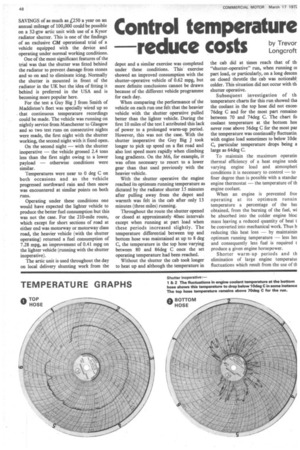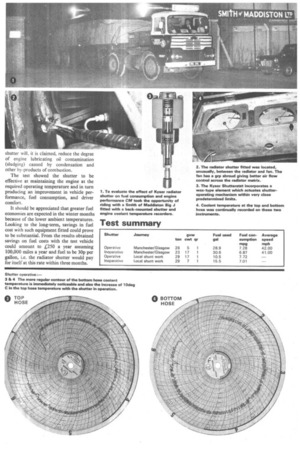Control temperature
Page 50

Page 51

If you've noticed an error in this article please click here to report it so we can fix it.
reduce costs by Trevor
Longcroft
SAVINGS of as much as £250 a year on an annual mileage of 100,000 could be possible on a 32-gtw artic unit with use of a Kysor radiator shutter. This is one of the findings of an exclusive CM operational trial of a vehicle equipped with the device and operating under normal working conditions.
One of the most significant features of the trial was that the shutter was fitted behind the radiator to prevent damage from stones and so on and to eliminate icing. Normally the shutter is mounted in front of the radiator in the UK but the idea of fitting it behind is preferred in the USA and is becoming more popular here.
For the test a Guy Big J from Smith of Maddiston's fleet was specially wired up so that continuous temperature recordings could be made. The vehicle was running on nightly service from Manchester to Glasgow and so two test runs on consecutive nights were made, the first night with the shutter working, the second night with it fixed open.
On the second night — with the shutter inoperative — the vehicle grossed 2.4 tons less than the first night owing to a lower payload — otherwise conditions were similar.
Temperatures were near to 0 deg C on both occasions and as the vehicle progressed northward rain and then snow was encountered at similar points on both runs.
Operating under these conditions one would have expected the lighter vehicle to produce the better fuel consumption but this was not the case. For the 210-mile route, which except for short sections of road at either end was motorway or motorway class road, the heavier vehicle (with the shutter operating) returned a fuel consumption of 7.28 mpg, an improvement of 0.41 mpg on the lighter vehicle (running with the shutter inoperative).
The artic unit is used throughout the day on local delivery shunting work from the depot and a similar exercise was completed under these conditions. This exercise showed an improved consumption with the shutter-operative vehicle of 0.62 mpg, but more definite conclusions cannot be drawn because of the different vehicle programme for each day.
When comparing the performance of the vehicle on each run one felt that the heavier vehicle with the shutter operative pulled better than the lighter vehicle. During the first 10 miles of the test I attributed this lack of power to a prolonged warm-up period. However, this was not the case. With the shutter inoperative the Guy Big J took longer to pick up speed on a flat road and also lost speed more rapidly when climbing long gradients. On the M6, for example, it was often necessary to resort to a lower gear than that used previously with the heavier vehicle.
With the shutter operative the engine reached its optimum running temperature as dictated by the radiator shutter 15 minutes after pulling away from the depot and warmth was felt in the cab after only 13 minutes (three miles) running.
Throughout the route the shutter opened or closed at approximately 40sec intervals except when running at part load when these periods increased slightly. The temperature differential between top and bottom hose was maintained at up to 8 deg C, the temperature in the top hose varying between 80 and 86deg C once the set operating temperature had been reached.
Without the shutter the cab took longer to heat up and although the temperature in the cab did at times reach that of th "shutter-operative" run, when running ol part load, or particularly, on a long descen on closed throttle the cab was noticeabl colder. This situation did not occur with th shutter operative.
Subsequent investigation of th temperature charts for this run showed tha the coolant in the top hose did not excee 76deg C and for the most part remainel between 70 and 74deg C. The chart fo coolant temperature at the bottom hos never rose above 56deg C for the most par the temperature was continually fluctuatin with engine load sometimes to below 10de C, particular temperature drops being a large as 64deg C.
To maintain the maximum operatin thermal efficiency of a heat engine undr varying engine load and atmospheri conditions it is necessary to control — to finer degree than is possible with a standar engine thermostat — the temperature of th engine coolant.
When an engine is prevented fror operating at its optimum runnin temperature a percentage of the her obtained, from the burning of the fuel, wi be absorbed into the colder engine bloc mass leaving a reduced quantity of heat t be converted into mechanical work. Thus b reducing this heat loss by maintainin optimum running temperature — less her and consequently less fuel is required t produce a given engine horsepower.
Shorter warm-up periods and th elimination of large engine temperatur fluctuations which result from the use of tk shutter will, it is claimed, reduce the degree of engine lubricating oil contamination (sludeing) caused by condensation and other by-products of combustion.
The test showed the shutter to be effective at maintaining the engine at the required operating temperature and in turn producing an improvement in vehicle performance, fuel consumption, and driver comfort.
It should be appreciated that greater fuel economies are expected in the winter months because of the lower ambient temperatures. Looking to the long-term, savings in fuel cost with such equipment fitted could prove to be substantial. From the results obtained savings on fuel costs with the test vehicle could amount to £250 a year assuming 100,000 miles a year and fuel to be 30p per gallon, i.e. the radiator shutter would pay for itself at this rate within three months.










































































































